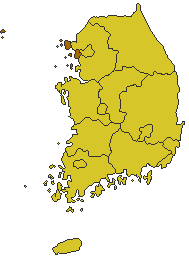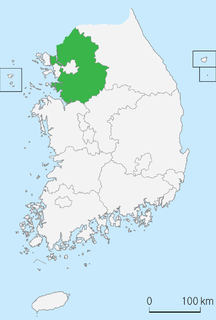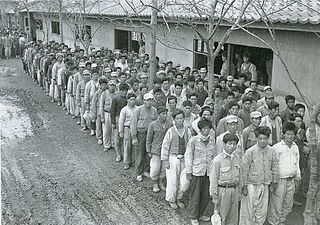 W
WThe Bodo League massacre was a massacre and war crime against communists and suspected sympathizers that occurred in the summer of 1950 during the Korean War. Estimates of the death toll vary. Historians and experts on the Korean War estimate that the full total ranges from at least 60,000–110,000 to 200,000. The massacre was wrongly blamed on the communists. The South Korean government made efforts to conceal this massacre for four decades. Survivors were forbidden by the government from revealing it, under suspicion of being communist sympathizers; whilst public revelation carried with it the threat of torture and death. During the 1990s and onwards, several corpses were excavated from mass graves, resulting in public awareness of the massacre.
 W
WThe Ganghwa massacre was a massacre conducted by the South Korean forces, South Korean Police forces and pro-South Korean militiamen, between 6 and 9 January 1951, of 212 to 1,300 unarmed civilians in the Ganghwa county of the Incheon metropolitan city in South Korea. The victims were collaborators with the Korean People's Army during North Korean rule. Before this massacre, 140 people were executed in Ganghwa as part of the Bodo League massacre in 1950.
 W
WThe Geochang massacre was a massacre conducted by the third battalion of the 9th regiment of the 11th Division of the South Korean Army between 9 February 1951 and 11 February 1951 of 719 unarmed citizens in Geochang, South Gyeongsang district of South Korea. The victims included 385 children. The 11th Division also conducted the Sancheong-Hamyang massacre two days earlier. The general commanding the division was Choe Deok-sin.
 W
WThe Goyang Geumjeong Cave massacre was a massacre of over 153 unarmed civilians conducted between 9 October 1950 and 31 October 1950 by police in Goyang, Gyeonggi-do district of South Korea. After the victory of the Second Battle of Seoul, South Korean authorities arrested and summarily executed several individuals along with their families on suspicion of sympathizing with North Korea. The killings in Goyang coincided with the Namyangju Massacre in nearby Namyangju.
 W
WThe Hangang Bridge bombing was a demolition operation conducted by the South Korean Army to destroy the Hangang Bridge in Seoul, South Korea, on 28 June 1950, to delay the rapid North Korean advance towards the city.
 W
WThe Namyangju massacre was a mass killing conducted by South Korean police and local militia forces between October 1950 and early 1951 in Namyangju, Gyeonggi-do district of South Korea. More than 460 people were summarily executed, including at least 23 children under the age of 10. After the victory of the Second Battle of Seoul, South Korean authorities arrested and summarily executed several individuals along with their families on suspicion of sympathizing with North Korea. During the massacre, South Korean Police conducted the Goyang Geumjeong Cave Massacre in Goyang near Namyangju. The killings in Namyangju coincided with a similar massacre committed in nearby Goyang.
 W
WThe National Defense Corps Incident was a death march that occurred in the winter of 1951 during the Korean War.
 W
WThe No Gun Ri massacre occurred on July 26–29, 1950, early in the Korean War, when an undetermined number of South Korean refugees were killed in a U.S. air attack and by small- and heavy-weapons fire of the 7th Cavalry Regiment at a railroad bridge near the village of Nogeun-ri, 100 miles (160 km) southeast of Seoul. In 2005, a South Korean government inquest certified the names of 163 dead or missing and 55 wounded, and added that many other victims' names were not reported. The No Gun Ri Peace Foundation estimated in 2011 that 250–300 were killed, mostly women and children.
 W
WThe Sancheong and Hamyang massacre was a massacre conducted by a unit of the South Korean Army 11th Division during the Korean War. On 7 February 1951, 705 unarmed citizens in Sancheong and Hamyang, South Gyeongsang district of South Korea were killed. The victims were civilians and 85% of them were women, children and elderly people. The 11th Division also conducted the Geochang massacre two days later. The division's commanding general was Choe Deok-sin.
 W
WThe Seoul National University Hospital massacre was a massacre committed by the North Korea's Korean People's Army on 28 June 1950 of 700 to 900 doctors, nurses, inpatient civilians and wounded soldiers at the Seoul National University Hospital, Seoul district of South Korea. During the First Battle of Seoul, the KPA wiped out one platoon which guarded Seoul National University Hospital on 28 June 1950. They massacred medical personnel, inpatients and wounded soldiers. The Korean People's Army shot or buried the people alive. The civilian victims alone numbered 900. According to South Korean Ministry of National Defense, the victims included 100 wounded South Korean soldiers.
 W
WThe Sinchon Massacre was an alleged massacre of civilians between 17 October and 7 December 1950, in or near the town of Sinchon. North Korean sources claim the massacre was committed by South Korean military forces under the authorization of the U.S. military and that 30–35,000 people were killed. Other sources dispute the death toll and accuse Korean right-wing security police and communists of the killings. The event allegedly took place during the second phase of the Korean War and the retreat of the DPRK government from Hwanghae Province.